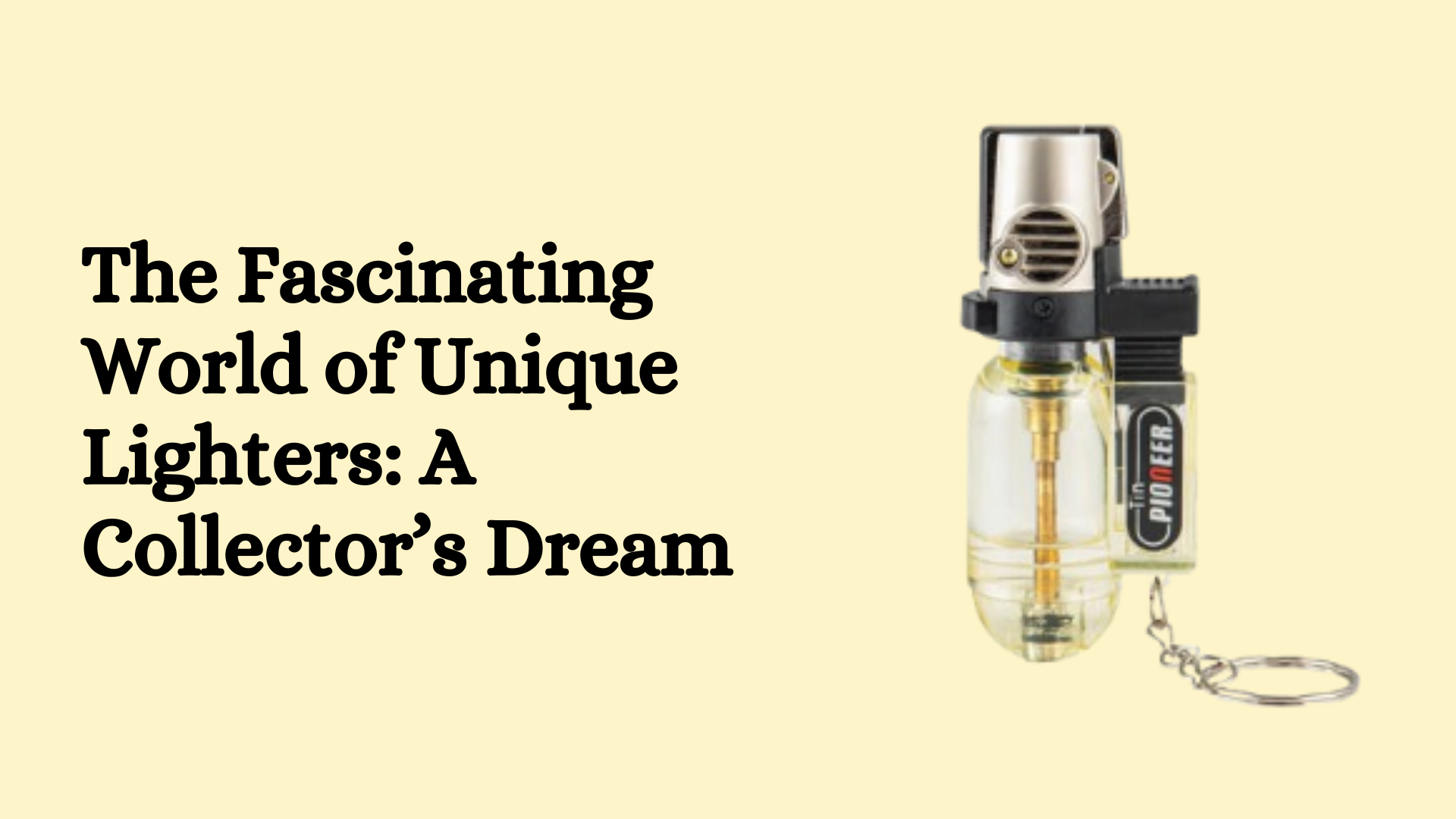The Fascinating World of Unique Lighters: A Collector’s Dream
- 1 The Historical Evolution of Lighters
- 2 Types of Unique Lighters
- 2.1 1. Zippo Lighters
- 2.2 2. Ronson Lighters
- 2.3 3. Dunhill Lighters
- 2.4 4. S.T. Dupont Lighters
- 2.5 5. Bic Lighters
- 3 The Art of Collecting Lighters
- 3.1 1. Historical Significance
- 3.2 2. Design and Aesthetics
- 3.3 3. Brand Prestige
- 3.4 4. Technological Innovation
- 4 Caring for a Lighter Collection
- 4.1 1. Storage
- 4.2 2. Cleaning
- 4.3 3. Functionality
- 5 Notable Lighter Collections and Museums
- 6 Conclusion
Lighters are more than just practical devices; they are intricate works of art, pieces of history, and symbols of culture. Collecting unique lighters is a hobby that combines elements of design, technology, and historical significance. For many, these small yet fascinating objects represent a captivating journey through time, offering insights into various eras and societies. This article delves into the world of unique lighters, exploring their history, types, notable brands, and ttheir appealfor collectors.
The Historical Evolution of Lighters
The history of lighters can be traced back to the early 19th century. The first lighters were essentially modified flintlock pistols. In 1823, Johann Wolfgang Döbereiner, a German chemist, invented the Döbereiner’s lamp, which used a chemical reaction between zinc and sulfuric acid to create hydrogen gas ignited by a platinum sponge. This early design paved the way for the developing of more practical and portable lighters.
By the late 19th and early 20th centuries, advancements in materials and technology led to the creation of more sophisticated lighters. The invention of the friction wheel in 1903 by Carl Auer von Welsbach revolutionized lighter design, allowing for easier ignition. The Zippo lighter, introduced in 1933 by George G. Blaisdell, became an iconic American product renowned for its reliability and distinctive “click.”
Types of Unique Lighters
Lighters come in various shapes, sizes, and mechanisms. Here are some of the most notable types:
1. Zippo Lighters
Zippo lighters are perhaps the most famous globally, known for their windproof design and lifetime warranty. Collectors value Zippos for their durability and the vast array of designs, including limited editions, commemorative models, and custom engravings.
2. Ronson Lighters
Ronson, an American brand, was a significant player in the lighter industry during the 20th century. Known for their innovation, Ronson lighters were among the first to feature an automatic ignition mechanism, making them highly desirable among collectors.
3. Dunhill Lighters
Dunhill lighters are synonymous with luxury and elegance. This British brand produces high-end lighters twithprecious metals and intricate designs. Collectors seek out vintage Dunhill lighters for their craftsmanship and aesthetic appeal.
4. S.T. Dupont Lighters
S.T. Dupont, a French luxury brand, is renowned for its exquisite lighters. These lighters are often made from precious metals and adorned with lacquer and gemstones. When opening a Dupont lighter, the signature “cling” sound was the brand’s quality hallmark.
5. Bic Lighters
While Bic lighters are mass-produced and widely used, specific limited editions and vintage models have become collectible items. Bic frequently collaborates with artists and brands, producing unique designs that attract collectors.
The Art of Collecting Lighters
Collecting lighters is a hobby that appeals to a wide range of enthusiasts. Some are drawn to the history and craftsmanship, while others appreciate the artistic designs and technological innovations. Here are some critical aspects of lighter collecting:
1. Historical Significance
Many collectors focus on lighters with historical significance. For example, military-issued lighters from World War II are highly prized for their historical value and the stories they represent. These lighters often have engravings or markings that reflect their origins and the events they witnessed.
2. Design and Aesthetics
The design and aesthetic appeal of lighters are significant factors for collectors. Art Deco lighters from the 1920s and 1930s, with their sleek lines and geometric patterns, are particularly sought after. Limited edition lighters featuring artwork, engravings, or unique shapes attract collectors.
3. Brand Prestige
Brands like Zippo, Dunhill, and S.T. Dupont have a loyal following due to their reputation for quality and innovation. Collectors often seek out rare and limited edition models from these brands, appreciating the prestige and craftsmanship associated with them.
4. Technological Innovation
The technological evolution of lighters is another fascinating aspect for collectors. Early lighters that employed innovative mechanisms, such as the Ronson Touch-Tip or the Dunhill Unique, showcase the ingenuity of their time. Collectors value these pieces for their mechanical complexity and historical importance.
Caring for a Lighter Collection
Maintaining a lighter collection involves proper care and storage. Here are some tips to ensure your collection remains in pristine condition:
1. Storage
Store lighters in a cool, dry place to prevent rust and corrosion. Display cases with glass fronts can protect lighters from dust while allowing them to be showcased. For valuable and delicate lighters, consider using padded cases to prevent scratches and damage.
2. Cleaning
Regular cleaning is essential to maintain the appearance and functionality of lighters. Use a soft cloth to wipe down the exterior and remove fingerprints. For metal lighters, a metal polish can help restore their shine. Be cautious with antique lighters, as harsh cleaning products can damage their finish.
3. Functionality
For still-functional lighters, occasional use can help maintain their working condition. Ensure they are refilled with the appropriate fuel and the flints are replaced as needed. Avoid using old or degraded fuel, as it can damage the lighter’s internal mechanisms.
Notable Lighter Collections and Museums
Several museums and private collections aworldwideare dedicated to lighters, showcasing their historical and artistic significance.
1. The Zippo/Case Museum
Located in Bradford, Pennsylvania, the Zippo/Case Museum offers a comprehensive look at the history of Zippo lighters. The museum features thousands of lighters, including rare and limited edition models, and aandexhibits on the manufacturing process and the brand’s cultural impact.
2. Tokyo Fire Museum
The Tokyo Fire Museum in Japan includes an extensive collection of lighters, highlighting their role in firefighting history. The museum features lighters from various eras and regions, providing a global perspective on lighter design and technology.
3. Private Collections
Many lighter collectors have amassed significant private collections, some of which are occasionally showcased in exhibitions. These collections often feature rare and unique pieces, providing a glimpse into the diverse world of lighters.
Conclusion
The world of unique lighters is a fascinating realm where history, art, and technology converge. For collectors, lighters are not merely tools for ignition but treasured artifacts that tell stories of bygone eras, reflect cultural shifts, and showcase human ingenuity. Collecting lighters offers a rich and rewarding journey through the ages, whether you are drawn to the historical significance, the intricate designs, or the prestige of renowned brands.

















